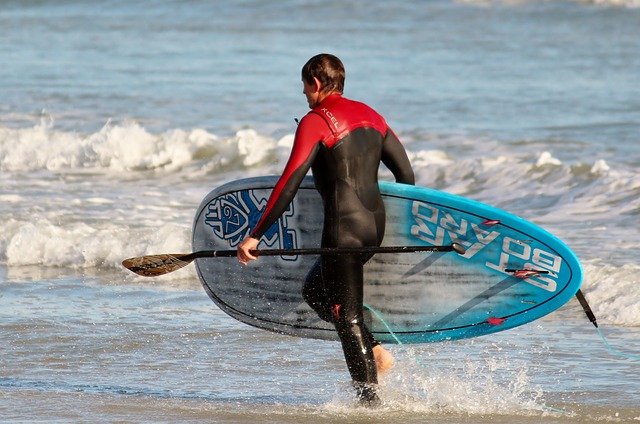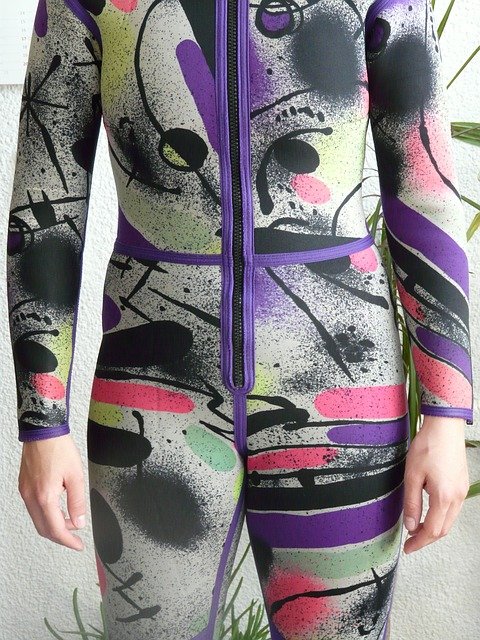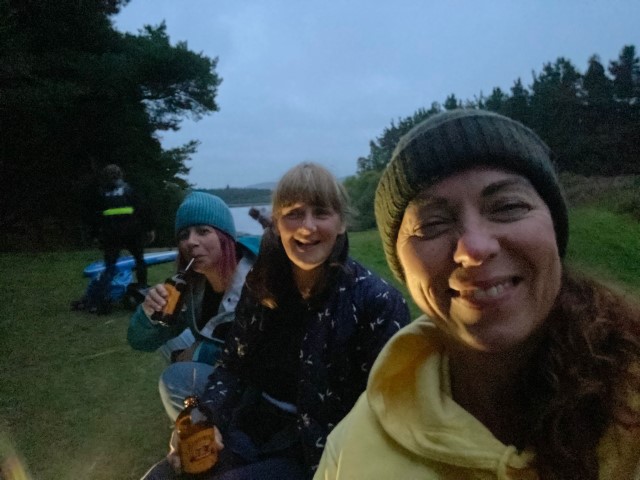Paddle boarding in cold or even sub-zero temperatures is no fun at all if you do not have the proper gear on, or have not best prepared yourself for a cold weather experience.
Many outdoor activities are done in cold weather including Kayaking, Fishing, and even paddleboard Yoga! The same advice would apply to most of them – be prepared and properly kitted out to avoid at best a bad experience, and at worst utter tragedy.
Dangers associated with cold weather:
- Frostbite: This is especially the case where the temperatures have dropped below zero. The extremities like fingers and toes are the first to suffer from frostbite as the body redirects blood flow to warm the internal organs.
- Hypothermia: Similar to frostbite, hypothermia results from exposure to extreme cold – not necessarily below freezing. A cold wind can drop the temperature by 10 degrees or more and anything below 95 F (35 C) can result in hypothermia a life-threatening condition.
- Risk of accident: Be aware of your footing and surroundings at all times especially around lakes where the edges may be frozen. The risk of accidents around snow covered ground from hidden obstacles should not be under-estimated. Even a twisted ankle could lead to a life-threatening condition in the cold.
- Cold water shock: Falling into cold water can result in shock to the body, leading to cramps and drowning. Any water below 65F can be regarded as cold. Falling into extremely cold water results in gasping and hyperventilating which raises the heartbeat and can result in a heart attack and/or unconsciousness.
Apart from all that – cold weather paddleboarding is normally great fun!
On a serious note. To avoid any of the above happening to you or your friends when out paddling in cold weather, simply take note of these points and instead take the appropriate steps to be well prepared for your cold weather adventure.
The list below is a list of general precautions I would always adhere to when going paddleboarding or indeed Kayaking in cold weather.
This is mainly precautions when cold-water paddleboarding, but most of it applies equally well in warm weather.
- Never go out alone: Company equals security. If you do get into trouble, at least there is someone to help you out of it.
- Take warm gear: A good wetsuit or drysuit is essential, 4/5mm is best. Neoprene gloves, body warmers, cosy hat and boots – along with neoprene socks.
- Take spare clothes: Always remember to have a spare set of warm clothes with you. This is true even when warm-water boarding.
- Take a flask with a hot drink: Tea, coffee, juice, hot water – as long as its hot! Oh…and do use an unbreakable flask! From past experience I can tell you it’s a major bummer to open up your flask to be greeted by shattered glass in your coffee!
- Keep a warm blanket in the car: This is a general rule in the winter, and not only for outdoors adventures. Breaking down in the cold weather with no blanket in the car is a recipe for disaster.
- Life jacket: Always wear a life jacket or Personal Flotation Device – especially in colder weather. Shocking cold water can quickly reduce your core temperature, reducing your ability to swim dramatically should you fall in.
- Keep away from frozen water: Whilst it may be tempting to push your paddle board over the frozen water at the edge of a lake, it is fraught with danger. It might only be a foot or 2 from the edge to begin with, but after a few hours?
- Keep a watch on the weather forecast: Basic but important stuff. Weather might be fine to start with, but you could easily get yourself in trouble if it turns while you are in deep water, or the wind turns and blows you away from shore.
- Leave details with a friend. Just as in any outdoor pursuit, you should leave details of your trip with someone sensible, including when you expect to return. If the worst should happen at least you will know that somebody will put up the alarm.
As a general rule for cold weather paddleboarding. When making your plans assume you are going to fall in!
How would you cope/survive in this situation? This thought-process will help you to mentally and physically prepare for your cold-weather adventure.
The national weather service has a good post here about cold weather dangers.
Drysuit or Wetsuit for paddleboarding?

There is a huge range of choices when it comes to either option. However the first has to be the choice between a dry or a wetsuit when going paddleboarding – especially (but not confined to) cold weather.
Drysuit are designed to keep you dry (Duhhh!), but are in themselves quite cold and so appropriate thermal undergarments are needed to keep you warm. This can make drysuits quite bulky especially the 5mm suits needed for winter.
For this reason they are preferred mainly by kayakers who do not intend falling in, and do not require the same amount of body flexibility as paddle board users.
Wetsuits are designed to let the water in and warm up by trapping your own body heat in the thin layer of water between the suit and the skin. The thicker 5mm suits prevent the sudden rush of water and are better for the cold weather. Also you can wear a full-body baselayer for extra warmth.
The thing to remember is that there is not really a wrong choice between dry or wet suits for paddlers. Drysuits tend to be several times more expensive than wet – which ‘closes the deal’ for most paddleboarders!
The thing to keep in mind is that neither a dry or wet suit is designed to keep you warm – they are designed to slow down heat loss. It is the garments you wear on top or below the suit that is the deciding factor for actual body heat retention.
Final tip – Keep a good wind-proof jacket strapped to your board when you set out – if you are not already wearing it.
Gloves, Hats & Boots For Winter Paddleboarding
Do you need all this extra gear just because it’s a little cold out there? You’d better believe it! In winter conditions your hands and feet especially had better be well covered up if you are to avoid a thoroughly miserable experience or worse.
Hands and toes turning a pretty shade of orange with a blueish tinge is set to having you retreat to your warm car – or lose your digits!

That said. Good quality neoprene or even cotton gloves are an absolute must. There are many types to choose from but personally I prefer just a good pair of water-resistant thermal gloves (I have cold hands) better than the neoprene.
But really it’s a matter of choice. As long as they are warm and flexible enough for the paddle, then they will do just fine. Neoprene may have the advantage if they get soaked – but putting on freezing cold, wet neoprene gloves….seriously!
I just keep a spare pair of warm cotton gloves handy just in case.
As for headgear. If you are a kayaker you will need a thin thermal hood or ski-mask under your hard-hat to stop your ears falling off!
Paddleboarders tend to wear a range of headgear including woolly beanie hats, ski-masks, balaclavas and maybe even a warm scarf in really cold conditions.
Though the danger of overheating has to be considered, it’s easier to take things off and strap them to the board, than having to go back ashore because you are freezing cold.
What to wear on your feet is just as important. While it may be traditional (and preferable in most cases) to go barefoot. In the winter or really cold conditions this is just insane!
Again, there is a huge range to consider including neoprene liner socks, dry-socks and knee-length socks (my preference) for the paddler to wear in cold weather under their shoe or bootie choice.
Neoprene booties are a good choice for the feet, and they offer a good grip on the board as well. However a cheap pair of trainers with good socks will do just as well.

Checklist for Winter Paddleboarding
On top of your essentials, paddleboard, paddle, PFD, and leash. This is a quick checklist of winter considerations.
- Warm clothing including jacket, gloves, hat, shoes or booties.
- Warm drink in an unbreakable flask or thermos.
- Leave details of your trip with someone, including your expected return time.
- Take a friend or companion along with you.
- Take spare dry clothing/blankets
- Check the weather forecast.
Winter Paddleboarding Conclusion:
To be fair, I know lots of people who simply put away their Paddle Boards at the end of the Fall season and approach to winter. This is especially the case in the colder Northern territories where temperatures will regularly go below freezing – and stay there for the winter.
However for those who are able to do so, winter Paddleboarding can be great fun – as long as you are prepared for it.
One of the reasons I like it is that it is a lot quieter, for the same reasons just observed. Not everyone like to go out in the cold.
However the serene, quiet nature of paddleboarding in the cold winter is just a completely different experience altogether than summer boarding – just get well wrapped up.
Be safe. Enjoy!
Recent Posts
Our latest Paddleboard adventure comes mainly thanks to driftwoodadventures! They kindly arranged the whole thing for us - which is important to us especially, as we were not sure of the...
What Fitness Level Do I Need For Stand Up Paddleboarding (SUP)?
Stand-Up Paddleboarding (SUP) is a fantastic water sport that has grown significantly in popularity in recent years. It's a fun and accessible activity that allows you to enjoy the outdoors and get...